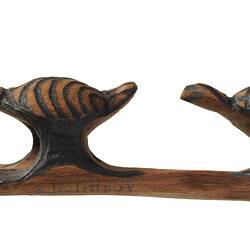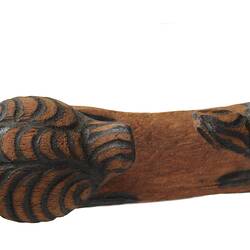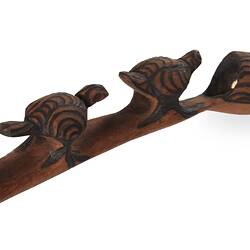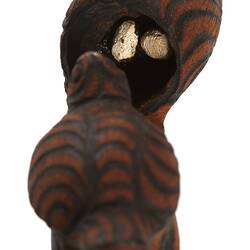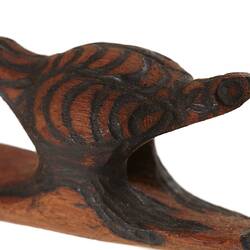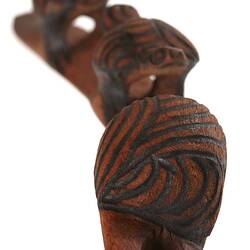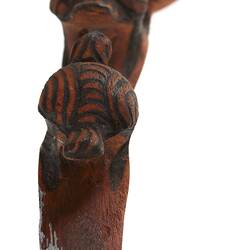Summary
Niningka Lewis is highly regarded for her innovative creativity, producing original punu (wood carvings) such as this Nyii-Nyii (Zebra Finch).
'We are all great carvers and love carving wood. It is something we do. Something we have done for a very long time and we are not about to give it up. We didn't give up wood carving when basket making came along! We now do both! We carve wood and then we make baskets, and then get back to carving wood and then we get back to baskets. If we get stiff and tired doing one thing, we'll change our tools and pick up the other craft. It's all good ergonomics!'
Niningka Lewis.
Born in 1945, Niningka is known for her innovative and unusual style and her punu (carvings) have featured in many exhibitions. Growing up in the Ernabella area, where she now lives, Niningka made regular trips with her family throughout her traditional lands. She is a highly respected artist who works with Ernabella Arts, an Aboriginal owned and run corporation which supports the ethical production and sale of Indigenous Art. Nininingka also works with the award-winning Tjampi Desert Weavers who sculpt and weave native grass objects
Local Name
Nyii-nyii
Physical Description
Carving of two birds and a nest on a branch made from a River Redgum root. Two birds sit on branch with nest at end of branch with two 'eggs' inside nest which are attached with resin. Nest and birds are decorated with pokerwork designs of concentric arcs.
Significance
The Nyii-Nyii is the most common finch found in Central Australia. It is quite adaptable and is varied in its nesting habits, with nests created in a variety of places, including cavities, scrub, low trees, bushes, on the ground and termite hills.
Anangu stories in Tjukurrpa, the force that unites Anangu (people from the Central and Western Deserts) with each other and with the landscape, tell of the travels of these bird ancestors, and a Nyii-Nyii inma (ceremony) is an important part of ceremonial life. Niningka reflects on the importance of punu in the lives of her people;
'Looking at punu brings back memories of old people, memories of good times going out collecting punu, sitting around fires carving and burning designs with hot wires. Punu evokes the stories of the Tjukurpa but also good memories of family, of artists and the strength of their creative talent. As people have passed away, as people have created new and exciting work, pieces have been added to the collection, to this bank of memories.' Niningka Lewis, 2014
More Information
-
Object/Medium
Animal figure
-
Maker
-
Cultural Groups
-
Locality
-
Date Produced
-
Collector
-
Date Collected
-
Object Measurements
325 mm (Length), 70 mm (Width), 60 mm (Height)
-
Classification
-
Date Made
-
Maker
-
Clan/Language Group
-
Place Made
-
Indigenous Region
-
Keywords
-
Type of item
-
Discipline
-
Category
-
Collecting Areas

